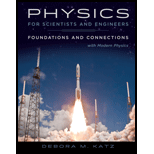
Concept explainers
(a)
The speed of each point in meters per second.
(a)
Answer to Problem 32PQ
The speed of the point at the outer end of the blade having length
Explanation of Solution
Write the equation connecting linear speed and the angular speed of a point.
Here,
It is given that both the blades have the same angular speed.
Use equation (I) to find the expression for the linear speed of the point at the outer end of the blade having length
Here,
Use equation (I) to find the expression for the linear speed of the point at the outer end of the blade having length
Here,
Conclusion:
It is given that the angular speed is
Substitute
Substitute
Therefore, the speed of the point at the outer end of the blade having length
(b)
The angular distance travelled by each point.
(b)
Answer to Problem 32PQ
The angular distance travelled by each point is
Explanation of Solution
Write the equation for the
Here,
Rewrite the above equation for
Equation (IV) shows that angular distance travelled by each point is same since both the blades have same angular speed.
Conclusion:
It is given that the motion is considered for
Substitute
Therefore, the angular distance travelled by each point is
(c)
The translational distance travelled by each point.
(c)
Answer to Problem 32PQ
The translational distance travelled by the point at the outer end of the blade having length
Explanation of Solution
The translational distance travelled by each point will be equal to the arc length subtended by the angular displacement of each point.
Write the equation for the arc length.
Here,
Use equation (V) to find the expression for translational distance travelled by the point at the outer end of the blade having length
Here,
Use equation (V) to find the expression for translational distance travelled by the point at the outer end of the blade having length
Here,
Conclusion:
Substitute
Substitute
Therefore, the translational distance travelled by the point at the outer end of the blade having length
(d)
The magnitude of centripetal acceleration that would be experienced by an object located at each point.
(d)
Answer to Problem 32PQ
The magnitude of centripetal acceleration that would be experienced by an object located at the point at the outer end of the blade having length
Explanation of Solution
Write the equation for the centripetal acceleration.
Here,
Use equation (VIII) to find the expression for the centripetal acceleration that would be experienced by an object located at the point at the outer end of the blade having length
Here,
Use equation (VIII) to find the expression for the centripetal acceleration that would be experienced by an object located at the point at the outer end of the blade having length
Here,
Conclusion:
Substitute
Substitute
Therefore, the magnitude of centripetal acceleration that would be experienced by an object located at the point at the outer end of the blade having length
Want to see more full solutions like this?
Chapter 12 Solutions
Webassign Printed Access Card For Katz's Physics For Scientists And Engineers: Foundations And Connections, 1st Edition, Single-term
- (a) For a spherical capacitor with inner radius a and outer radius b, we have the following for the capacitance. ab C = k₂(b- a) 0.0695 m 0.145 m (8.99 × 10º N · m²/c²)( [0.145 m- 0.0695 m × 10-11 F = PF IIarrow_forwardA pendulum bob A (0.5 kg) is given an initialspeed of vA = 4 m/s when the chord ishorizontal. It then hits a stationary block B (1kg) which then slides to a maximum distanced before it stops. Determine the value of d.The coefficient of static friction between theblock and the plane is μk = 0.2. The coefficientof restitution between A and B is e = 0.8.Ans: d=1.0034 marrow_forwardFigure 29-43 Problem 12. ••13 In Fig. 29-44, point P₁ is at distance R = 13.1 cm on the perpendicular bisector of a straight wire of length L = 18.0 cm carrying current i = 58.2 mA. (Note that the wire is not long.) What is the magnitude of the magnetic field at P₁ due to i? P2° R R Larrow_forward
- Checkpoint 1 The figure shows the current i in a single-loop circuit with a battery B and a resistance R (and wires of neg- ligible resistance). (a) Should the emf arrow at B be drawn pointing leftward or rightward? At points a, B C R b, and c, rank (b) the magnitude of the current, (c) the electric potential, and (d) the electric potential energy of the charge carriers, greatest first.arrow_forwardPls help ASAParrow_forwardPls help asaparrow_forward
 Principles of Physics: A Calculus-Based TextPhysicsISBN:9781133104261Author:Raymond A. Serway, John W. JewettPublisher:Cengage Learning
Principles of Physics: A Calculus-Based TextPhysicsISBN:9781133104261Author:Raymond A. Serway, John W. JewettPublisher:Cengage Learning Physics for Scientists and Engineers: Foundations...PhysicsISBN:9781133939146Author:Katz, Debora M.Publisher:Cengage Learning
Physics for Scientists and Engineers: Foundations...PhysicsISBN:9781133939146Author:Katz, Debora M.Publisher:Cengage Learning Glencoe Physics: Principles and Problems, Student...PhysicsISBN:9780078807213Author:Paul W. ZitzewitzPublisher:Glencoe/McGraw-Hill
Glencoe Physics: Principles and Problems, Student...PhysicsISBN:9780078807213Author:Paul W. ZitzewitzPublisher:Glencoe/McGraw-Hill College PhysicsPhysicsISBN:9781305952300Author:Raymond A. Serway, Chris VuillePublisher:Cengage Learning
College PhysicsPhysicsISBN:9781305952300Author:Raymond A. Serway, Chris VuillePublisher:Cengage Learning Physics for Scientists and Engineers with Modern ...PhysicsISBN:9781337553292Author:Raymond A. Serway, John W. JewettPublisher:Cengage Learning
Physics for Scientists and Engineers with Modern ...PhysicsISBN:9781337553292Author:Raymond A. Serway, John W. JewettPublisher:Cengage Learning Physics for Scientists and EngineersPhysicsISBN:9781337553278Author:Raymond A. Serway, John W. JewettPublisher:Cengage Learning
Physics for Scientists and EngineersPhysicsISBN:9781337553278Author:Raymond A. Serway, John W. JewettPublisher:Cengage Learning





